“It Is Indeed a Holy Place”: Why a City in India is Rallying to Save a Mid-Century Cricket Stadium
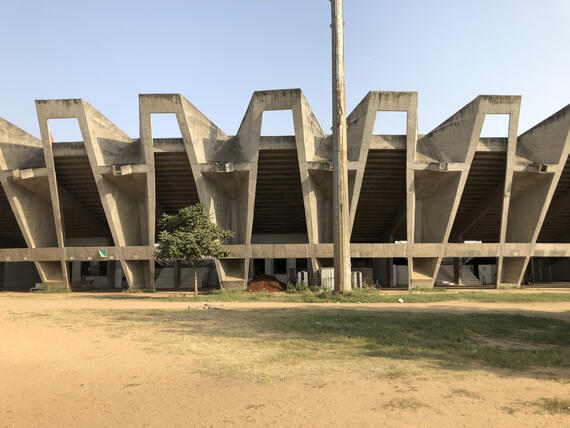
Ravindra Joshipura’s day often begins with an invigorating walk or run around the track at Sardar Vallabhbhai Patel Stadium in Ahmedabad, Gujarat, India. As he circles the grass inside the 50,000-seat stadium, the 74-year-old is reminded of his lifetime playing cricket as part of his school and workplace teams, often competing in matches at this very stadium. These days, the stadium is a free, convenient spot for him to train for half marathons (he’s completed 68 so far).
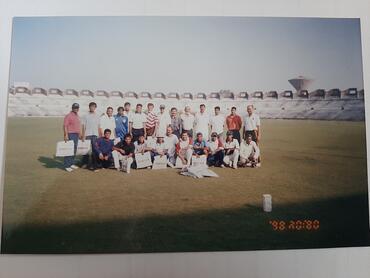
In this city of 8 million people, where population growth has led to more construction and less open space, Patel Stadium has become a much-needed spot for locals like Joshipura to gather outdoors, exercise, and hang out. It also remains a popular venue for domestic cricket matches. As the 55-year-old stadium ages, locals and cultural heritage conservators are rallying to preserve this essential community resource and beacon of cricket history.
“For me the stadium is indeed a holy place,” said Joshipura. “It evokes in me many past fond memories of cricket and cricketers I have played with and against. A couple of hours in the morning are a real tonic for me.”
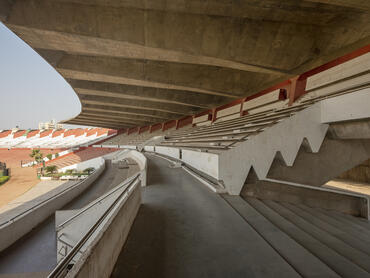
Designed by Indian architects Charles Correa and Mahendra Raj and completed in 1965, Patel Stadium stands in the heart of Ahmedabad. A geometric concrete frame forms the exterior of the stadium, with light, airy space below the seats for visitors to meander through. The stadium’s folded plate cantilevered roof also stands out. At nearly 65 feet high, it was perhaps the first time a roof of this kind, and at this scale, was attempted anywhere in the world.
The stadium is part of a constellation of structures built in Ahmedabad in the Modern architecture style by Indian and international architects following a period of post-colonial economic and social growth. Modern architecture became popular after World War I and emphasized functional, practical design, particularly in public spaces, housing, and workplaces, and used new materials like concrete and steel.
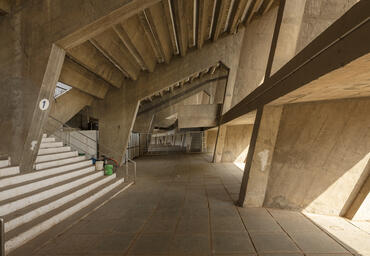
“Modernism in India goes hand-in-hand with its post-colonial history, where Modernism became a critical way to express a new national identity and architectural idiom,” said Javier Ors Ausín, an architect and program manager at the World Monuments Fund, a nonprofit organization that advocates for the preservation of significant architecture around the world.
WMF included the stadium in its 2020 World Monuments Watch to draw attention to the complex challenges of preserving not only an iconic twentieth-century modern structure, but an emblematic public space for the people of Ahmedabad. Ors Ausín is co-leading the project with Amita Baig, Executive Director of WMF India.
“The stadium is symbolic of India’s ability to innovate with limited resources and a clever use of manpower,” said Annabel Lopez, a heritage management consultant and one of the project leads on the Patel Stadium conservation project.
Cricket: A National Pastime
In 1721, sailors from a British ship that landed off the coast of western India played the first recorded cricket game in India. As Britain consolidated its rule over India throughout the 18th and 19th centuries, cricket spread through India. What began as a British sport, soon became part of Indian culture, with locals introducing new techniques and strategies that players still use today.
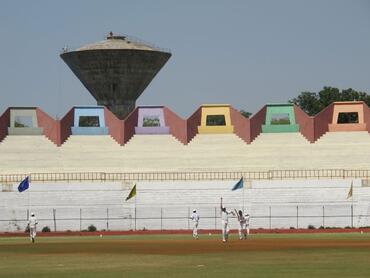
In 1911, a coalition of Indian princes, businessmen, and aristocrats, together with British governors, civil servants, and coaches formed the first Indian national cricket team. The team served key political functions: to unite diverse groups within India (the team included six Parsis, five Hindus, and three Muslims, and also included two members of the Dalit caste, the lowest in India); promote a positive, loyal vision of India under the British Empire; and boost India’s presence on the international cricket stage.
India gained independence from Britain in 1947, and in 1960, the state of Bombay was divided into the modern states of Gujarat and Maharashtra, with Ahmedabad becoming the capital of Gujarat from 1960-1970. Against this backdrop, and with Ahmedabad already considered a “mecca” of cricket, Patel Stadium was born.
Today, 300 years after that very first game in India, cricket is for many “almost a religion instead of a mere sport,” said Chirashree Thakkar, an architect working on the Patel Stadium conservation project, based in Ahmedabad. Cricket is so enmeshed in everyday life that many kids play throughout their school years, and adults compete on teams organized by their workplaces. With two World Cup wins, India’s international dominance in the sport is a point of national pride. “It would not be wrong to say that cricket is something that unites the nation.”
Saving the Stadium by Preserving Its History
Patel Stadium is now showing signs of physical degradation due to years of poor maintenance and lack of funding. In 2020, the Getty Foundation awarded the stadium a Keeping It Modern conservation grant to assist with its care and restoration so it can continue to host matches, and serve as a community hub. New dressing rooms, a gym, better parking, childcare facilities, an upgrade to make the facility camera- and TV-friendly, and an interactive cricket museum for schoolchildren have been proposed as part of the plan to upgrade and preserve the stadium.
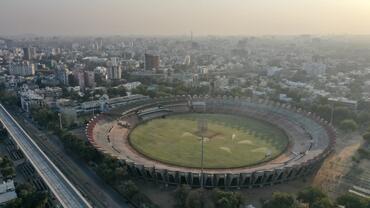
“There is a kind of emotional connection with the stadium for the people of Ahmedabad because it is a really majestic and huge building belonging to the post-independence era and is an outstanding architectural marvel,” Thakkar said. “Many players, too, who started their careers here, have very fond memories of this ground. All this demonstrates that the stadium needs to be preserved and celebrated, not demolished,” added Lopez.
The Ahmedabad community will help preserve Patel Stadium’s past and shape its future. Locals have been invited to share their feedback about the modernization project with the conservation team in a series of public forums, deepening the conservation team’s understanding of the significance of the stadium. All the responses will be analyzed to help formulate policies for the site’s management.
With the community’s guidance, Patel Stadium can continue to serve its integral role in Ahmedabad: as a meeting place, exercise spot, and haven for cricket lovers, old and new.
This article was originally published on July 20, 2021, in Getty News & Stories online.

WMF’s project to prepare a conservation management plan for Charles Correa’s Sardar Vallabhbhai Patel Stadium in Ahmedabad is made possible with support from the Getty Foundation through its Keeping It Modern initiative.
